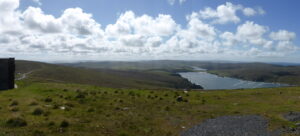
If you travel to Shetland today you will find a rather beautiful island chain that essentially comprises a series of steep hills. The topography is abrupt and dramatic; the landscape is gentler towards the coast, but in most places agricultural land is concentrated into small pockets. Numerous islands, of varying size, surround the main landmass.
Curiously, the islands have no indigenous land mammals. The evidence suggests that all, including otters and ponies, have been introduced by the earlier communities of Shetland. The early islanders were canny folk, well able to adapt their lifestyle and farming methods to make the most of the climate and conditions out on this north-western edge of the Atlantic landmass.
The history of the very specific conditions in Shetland brings to mind some pressing questions. If we go back far enough, to the millennia immediately after the Last Glacial Maximum, which ended in the northern hemisphere around 19,000 years ago, then a combination of lower relative sea-levels and land adjustment due to the weight of the ice mean that a great expanse of dry land connected Britain to the Continent. We call this land Doggerland and it is currently the subject of some serious research including work to investigate the topography, flora and fauna of the landscape.
Large quantities of animal bone have been recovered from Doggerland, from a variety of sources including fishing trawls and aggregate extraction. Much of this is Pleistocene, ie dating to before the present era, and it comprises the remains of mammoths, woolly rhinos, bear, lions, hippos, bison and so on. There are also elk and reindeer. And, of course, though they are rare, the remains of people have also been found.
Several of these species of animal were prey species that also occur on excavated archaeological sites in the countries that surround Doggerland, and there is a general assumption that the human inhabitants of Doggerland will have hunted them. It is, in fact, impossible to understand the early settlement of those bordering countries without taking in to account the hazy, but very real, idea that the hunter-gatherer communities who occupied them extended their ranges across lands that have since disappeared beneath the waves.
Indeed, when considering the recent re-discovery of tanged points in Orkney, the general impression is that they provide evidence of the fleeting presence of hunter-gatherer groups from Doggerland who, some 12,000 – 13,000 years ago, were keen, for whatever reason, to explore the north-west fringes of the landmass.
Which brings me back to Shetland. If it was possible for the Late Upper Palaeolithic hunters to access Orkney from Doggerland (whether across a stretch of open water or not), was it also possible for them to access Shetland? When, exactly, did Shetland become islands? If it was possible to get to Shetland overland, then it was also possible that Shetland was home to the animal species that flourished in Doggerland. Of course, you may say – there is no evidence for large mammals in early Shetland, but, I would reply – absence of evidence is not always evidence of absence. There has been little research in deposits of the right age in Shetland so it may be that the bone has just not been found. I’m not sure that we even know where to look. The dramatically lower sea-levels of the period mean that the Shetland we experience today is only part of the resource, only the tops of the Shetlandic mountains that the explorers of Doggerland would have known. It may well be that the best pockets of evidence lie underwater.
This is not just some fanciful questioning. If we really want to understand the nature of Shetland and its earliest population, then we need to understand its relationship with Doggerland. Although the arrival of the early farmers by boat and the animals they brought with them in fairly recent times, is well attested, it is possible, even probable, that there was an earlier Shetland, a place where herds of reindeer, or even mammoth, occasionally grazed and where, when they did, there were small groups of Palaeolithic hunters ready to make the most of the bounty of the land.
You must be logged in to post a comment.